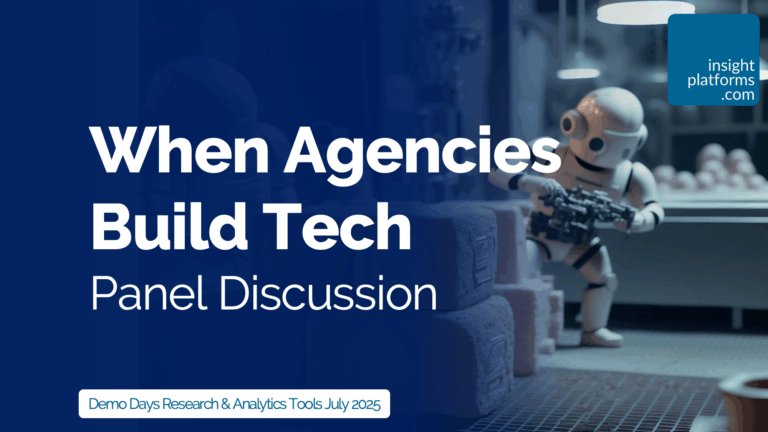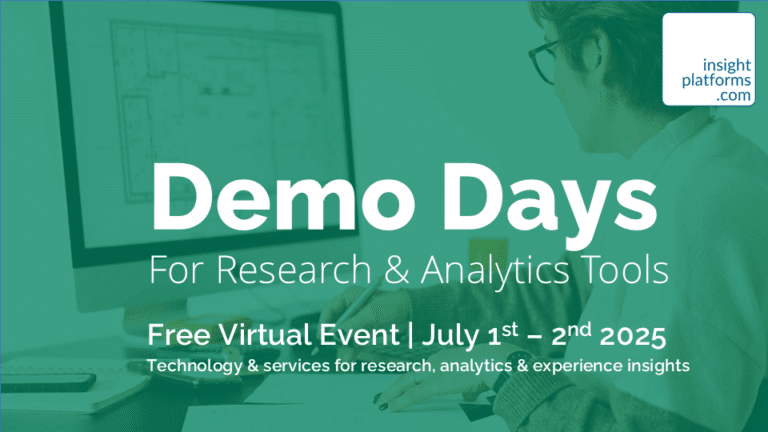
When Agencies Build Tech: Insights from Research Innovators
By Insight Platforms
- article
- AI
- Qualitative Research
The research industry is experiencing a significant transformation as traditional agencies develop their own technology solutions. While some tech investors and outsiders may view the market research sector as ripe for disruption, many innovative research firms are already leading this evolution from within, combining deep domain expertise with technological innovation.
At a recent Insight Platforms Demo Days panel discussion, leaders from four companies shared their journeys from traditional research backgrounds to technology development. These pioneers represent diverse geographical markets and technical specialisations, offering valuable insights for others considering a similar path.
Watch the replay of the session here:
When Agencies Build Tech: A Panel Discussion
The Journey from Agency to Tech Developer
Each panellist took a different route to technology development, reflecting various motivations and business contexts.
For Karin Nelsson, CEO of Sweden-based Demoskop, the journey began with internal pain points: “We were suffering with high staff turnover, and we also had problems with our profitability… we had very manual processes.” When ChatGPT emerged, Demoskop began experimenting with AI applications for research, eventually developing their own secure platform, the Stella Research Engine.
Serigne Fall, co-founder of LOOKA Research in Senegal, described a similar internal motivation: “Operations was just a pain at every project. Something as simple as just recruiting five people would take so much time.” What began as an internal tool for their design agency gradually evolved into a standalone research operations platform serving the complex African market.
Tovah Paglaro’s journey with Fathom followed yet another path. The technology was originally developed within Avalanche Insights, a public opinion research firm handling complex civic topics with large-scale open-ended responses. After operating as a tech-enabled agency, the company eventually made a strategic decision to separate the businesses.
“We sold the agency… we spent about six months really doing the market research, the product research to figure out what that core tech would need to be a product that was accessible for other researchers”, Paglaro explained.
For Touchstone Research, technology development was driven by client needs for secure content testing at scale. As Travis Santa, COO, noted: “We work a lot with media and entertainment clients. They want to test their content at scale. A lot of times, it’s pre-release content, so, obviously, there are security concerns.”
The Advantage of Researcher-Built Technology
A consistent theme throughout the discussion was the unique value that researchers bring to technology development. Unlike external tech companies entering the space, these agency-born solutions address real practitioner needs with a deep understanding of the domain.
“What makes us a little different is really around the level of nuance, detail and accuracy”, explained Paglaro about Fathom’s approach to qualitative analysis. “A lot of the automated solutions that exist are fine in those situations where you need kind of a good enough quick look. But not when you need to get into really detailed analysis.”
Nelsson highlighted three specific advantages researchers bring to technology development:
“We know sampling. We don’t need to analyse all the data around… The other thing is the quality control of data, so that we know what we are looking for… And the third one is our knowledge about statistical analysis, how to analyse data. These three points are solid in our bodies.”
This expertise allows research-driven tech companies to build solutions that maintain methodological rigour while embracing innovation, something outside tech companies often miss.
Managing the Tension Between Agency and Product Mindsets
Perhaps the most significant challenge discussed was navigating the fundamental differences between service and product business models. This tension manifests in team dynamics, resource allocation, and organisational culture.
Fall described it as “a story of tension” that impacts how things develop: “At some point, you realise there’s a limit of how much you can scale… So it’s really a mindset shift.” The progression from agency to tech-enabled agency to product-led company requires difficult decisions about focus and resource allocation.
Paglaro emphasised the importance of clarity: “This is super fabulous and wonderful for you as long as you know what you are. If you try to be two things at the same time, you will break.”
She continued: “As soon as you start to offer the same technology… to external users, you’ve now got two different business models, with two different user types… suddenly conversations about what’s driving our product road map [become complicated].”
These tensions extend to capital allocation decisions. While agencies can fund operations from current revenue, product development often requires significant upfront investment before seeing returns.
Cultural Transformation and Team Dynamics
Successfully building technology within a research agency requires navigating team dynamics and fostering an innovative culture while respecting traditional research values.
Nelsson described creating an environment where exploration was encouraged: “If you can create a structure and a culture in the company where you’re allowed to be innovative, to criticise, to just ‘try it out’, and to fail, then eventually, you also start having fun.”
Her company implemented regular Stella workshops on Friday afternoons, where team members contributed ideas and explored possibilities, a practice that continues to drive innovation.
Travis Santa emphasised the importance of researcher involvement throughout the technology development process: “The key with not having tension is due to the fact that the researchers were directly involved and they continue to be involved… They’re the ones using the tools in the field.”
Practical Lessons and Advice
The panellists shared five practical insights for agencies considering technology development:
1. Focus on Specific Problems
Fall advised against trying to build technology that does everything: “You have to prioritise. This is the most important part of the quant research that we really want to extract from it. And then build a product around it. And not just necessarily, ‘I want to do everything’.”
2. Test Early with Real Users
Paglaro emphasised the importance of early validation: “Make sure that you are testing with an MVP as soon as you possibly can. It’s not like agency research, where it needs to be perfect before it goes out the door. You are hooped if you take that approach.”
3. Maintain Human Oversight with AI
As AI becomes integral to research technology, the panellists stressed the continued importance of human judgment. Nelsson highlighted the importance of having humans in the loop and shared a cautionary experience: “The summaries that we got from the language models were way too liberal, the conclusions, compared to what the actual result really said.”
4. Create Communication Channels
Santa highlighted the value of open communication: “Having clear lines of communication, having an open policy in terms of getting feedback from your researchers and your team, not having closed-off silos between your development team and your research team. I think that’s all key.”
5. Balance Perfectionism with Progress
“Trying to make a product perfect or customise it for every single use case or every single client, all that’s going to do is delay timelines”, Santa cautioned. Setting clear goals while avoiding excessive perfectionism helps ensure projects reach completion.
Conclusion
The transition from traditional research agency to technology provider presents significant challenges but also tremendous opportunities. The panellists demonstrated that deep research expertise combined with technological innovation creates solutions that truly address industry needs.
As Fall succinctly put it: “Stop being a purist, at the end of the day, people still want to make money. How do you sell research as a product, and how do you think you can sell research more as an infrastructure than a service?”. This perspective shift is essential as research budgets face increasing pressure.
For research professionals navigating this evolution, the experiences shared by these pioneers offer valuable guidance. Their diverse journeys – from Sweden to Senegal, from qualitative analysis to secure media testing – showcase the richness and resilience of the insights ecosystem.
Watch the full panel discussion and other sessions from the Demo Days for Research & Analytics Tools here.



